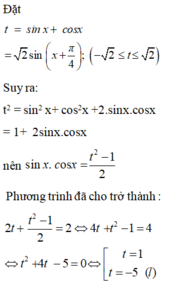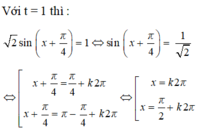2cos2x+ 4 cosx =1 +sinx- 2 sinxcosx

Những câu hỏi liên quan
Phương trình đối xứng với sinx và cosx
2cos2x + (sinxcosx-1) (sinx + cosx) = 0
\(\Leftrightarrow2\left(cos^2x-sin^2x\right)+\left(sinx.cosx-1\right)\left(sinx+cosx\right)=0\)
\(\Leftrightarrow\left(sinx+cosx\right)\left(2\left(cosx-sinx\right)+sinx.cosx-1\right)=0\)
\(\Leftrightarrow\left[{}\begin{matrix}sinx+cosx=0\\2\left(cosx-sinx\right)+sinx.cosx-1=0\end{matrix}\right.\)
TH1: \(sinx+cosx=0\Leftrightarrow sin\left(x+\frac{\pi}{4}\right)=0\)
\(\Rightarrow x=-\frac{\pi}{4}+k\pi\)
TH2: \(2\left(cosx-sinx\right)+sinx.cosx-1=0\)
Đặt \(cosx-sinx=-\sqrt{2}sin\left(x-\frac{\pi}{4}\right)=a\) (\(\left|a\right|\le\sqrt{2}\))
\(\Rightarrow a^2=1-2sinx.cosx\Rightarrow sinx.cosx=\frac{1-a^2}{2}\)
\(2a+\frac{1-a^2}{2}-1=0\)
\(\Leftrightarrow a^2-4a+1=0\Rightarrow\left[{}\begin{matrix}a=2+\sqrt{3}\left(l\right)\\a=2-\sqrt{3}\end{matrix}\right.\)
\(\Rightarrow-\sqrt{2}sin\left(x+\frac{\pi}{4}\right)=2-\sqrt{3}\)
\(\Rightarrow sin\left(x+\frac{\pi}{4}\right)=\frac{\sqrt{3}-2}{\sqrt{2}}=sin\alpha\)
\(\Rightarrow...\)
Nghiệm thứ 2 xấu vậy, bạn có ghi đề nhầm chỗ nào ko nhỉ?
Đúng 0
Bình luận (0)
\(1.\left(sinx+cosx\right)^3+sinxcosx-1=0\)
\(2.\left(sinx+cosx\right)^4-3sin2x-1=0\)
\(3.sin^3x+cos^3x+2\left(sinx+cosx\right)-3sin2x=0\)
\(4.\left(sinx-cosx\right)^3=1+sinxcosx\)
5.\(sinx+cosx+2+tanx+cotx+\frac{1}{sinx}+\frac{1}{cosx}=0\)
1.
Đặt \(sinx+cosx=t\Rightarrow\left\{{}\begin{matrix}\left|t\right|\le\sqrt{2}\\sinx.cosx=\frac{t^2-1}{2}\end{matrix}\right.\)
Pt trở thành:
\(t^3+\frac{t^2-1}{2}-1=0\)
\(\Leftrightarrow2t^3+t^2-3=0\)
\(\Leftrightarrow\left(t-1\right)\left(2t^2+3t+3\right)=0\)
\(\Leftrightarrow t=1\)
\(\Leftrightarrow sin\left(x+\frac{\pi}{4}\right)=\frac{\sqrt{2}}{2}\)
\(\Leftrightarrow\left[{}\begin{matrix}x+\frac{\pi}{4}=\frac{\pi}{4}+k2\pi\\x+\frac{\pi}{4}=\frac{3\pi}{4}+k2\pi\end{matrix}\right.\)
\(\Leftrightarrow...\)
b.
Đặt \(sinx+cosx=t\Rightarrow\left\{{}\begin{matrix}\left|t\right|\le\sqrt{2}\\sin2x=2sinx.cosx=t^2-1\end{matrix}\right.\)
Pt trở thành:
\(t^4-3\left(t^2-1\right)-1=0\)
\(\Leftrightarrow t^4-3t^2+2=0\)
\(\Leftrightarrow\left[{}\begin{matrix}t^2=1\\t^2=2\end{matrix}\right.\)
\(\Leftrightarrow\left[{}\begin{matrix}1+sin2x=1\\1+sin2x=2\end{matrix}\right.\)
\(\Leftrightarrow\left[{}\begin{matrix}sin2x=0\\sin2x=1\end{matrix}\right.\)
\(\Leftrightarrow...\)
Đúng 0
Bình luận (0)
3.
\(\Leftrightarrow\left(sinx+cosx\right)\left(1-sinx.cosx\right)+2\left(sinx+cosx\right)-6sinx.cosx=0\)
Đặt \(sinx+cosx=t\Rightarrow\left\{{}\begin{matrix}\left|t\right|\le\sqrt{2}\\sinx.cosx=\frac{t^2-1}{2}\end{matrix}\right.\)
Pt trở thành:
\(t\left(1-\frac{t^2-1}{2}\right)+2t-3\left(t^2-1\right)=0\)
\(\Leftrightarrow-t^3-6t^2+7t+6=0\)
Nghiệm của pt bậc 3 này rất xấu, chắc bạn ghi ko đúng đề bài
Đúng 0
Bình luận (0)
Xem thêm câu trả lời
giải các phương trình sau:
1) \(\sqrt{3}sin^2x+\left(1-\sqrt{3}\right)sinxcosx-cos^2x+1-\sqrt{3}=0\)
2) \(9sin^2x-30sinxcosx+25cos^2x=25\)
3) \(sin2x-2sin^2x=2cos2x\)
4) \(sin^3x-cos^3x=sinx+cosx\)
5)\(4\left(sin^3x+cos^3x\right)=sinx+cosx\)
mik lm biếng quá mik chỉ nói cách làm thôi nha bạn
1) chia hai vế cho cos^2(x) \(\sqrt{3}tan^2x+\left(1-\sqrt{3}\right)tanx-1+\left(1-\sqrt{3}\right)\left(1+tan^2x\right)=0\)
đặt t = tanx rr giải thôi =D ( máy 570 thì mode5 3 còn máy 580 thì mode 9 2 2) :)))
2) cx làm cách tương tự chia 2 vế cho cos^2x
3) giữ vế trái bung vế phải ra
\(sin2x-2sin^2x=2-4sin^22x\)
đặt t = sin2x (-1=<t=<1)
4) đẩy sinx cosx qua trái hết
\(sinx\left(sin^2-1\right)-cosx\left(cos^2x+1\right)=0\)
\(sinx\left(-cos^2x\right)-cos\left(cos^2x+1\right)=0\)
\(-cos\left(sinxcosx+cos^2x+1\right)=0\)
cái vế đầu cosx=0 bn bik giả rr mà dễ ẹc à còn vế sau thì chia cho cos^2(x) như mấy bài trên rr sau đó đặt t = tanx rr bấm máy là ra thui :))
5)bung cái hằng đẳng thức ra sau đó đặt t=sinx+cosx (t thuộc [-căn(2) ; căn(2)]
khi đó ta có sinxcosx=1/2 sin2x= 1/2t^2 - 1/2
làm đi là ra à
giải phương trình:
1) \(2\sqrt{2}cos^3x\left(x-\frac{\pi}{4}\right)-3cosx-sinx=0\)
2) \(tanx.sin^2x-2sin^2x=3\left(cos2x+sinxcosx\right)\)
3) \(2sin^3x=cosx\)
4) \(6sinx-2cos^3x=\frac{5sin4xcosx}{2cos2x}\)
1) 2sinx + cosx = sin2x + 1
2) (1 + cosx)(1+sinx) = 2
3) 3cos4x - 8cos6x + 2cos2x +3 =0
4) sin3x + cos3x.sinx + cosx = \(\sqrt{2}\)cos2x
5) (2cosx -1)(2sinx + cosx) = sin2x - sinx
1. Cho sinx dfrac{2}{3} , x ∈ (0,dfrac{Pi}{2})Tính cosx, tanx , sin (x+dfrac{Pi}{4})2. Cho cos dfrac{1}{4} . Tính sinx, cos2x3. Cho tanx 2 . Tính cosx, sinxx ∈ (0,dfrac{Pi}{2})4. Rút gọn a) A cos2x - 2cos2x + sinx +1 b) B dfrac{cos3x+cos2x+cosx}{cos2x}
Đọc tiếp
1. Cho sinx = \(\dfrac{2}{3}\) , x ∈ (0,\(\dfrac{\Pi}{2}\))
Tính cosx, tanx , sin (x+\(\dfrac{\Pi}{4}\))
2. Cho cos = \(\dfrac{1}{4}\) . Tính sinx, cos2x
3. Cho tanx = 2 . Tính cosx, sinx
x ∈ (0,\(\dfrac{\Pi}{2}\))
4. Rút gọn a) A = cos2x - 2cos2x + sinx +1
b) B = \(\dfrac{cos3x+cos2x+cosx}{cos2x}\)
1.
\(0< x< \dfrac{\pi}{2}\Rightarrow cosx>0\)
\(\Rightarrow cosx=\sqrt{1-sin^2x}=\dfrac{\sqrt{5}}{3}\)
\(tanx=\dfrac{sinx}{cosx}=\dfrac{2}{\sqrt{5}}\)
\(sin\left(x+\dfrac{\pi}{4}\right)=\dfrac{\sqrt{2}}{2}\left(sinx+cosx\right)=\dfrac{\sqrt{10}+2\sqrt{2}}{6}\)
2.
Đề bài thiếu, cos?x
Và x thuộc khoảng nào?
3.
\(x\in\left(0;\dfrac{\pi}{2}\right)\Rightarrow sinx;cosx>0\)
\(\dfrac{1}{cos^2x}=1+tan^2x=5\Rightarrow cos^2x=\dfrac{1}{5}\Rightarrow cosx=\dfrac{\sqrt{5}}{5}\)
\(sinx=cosx.tanx=\dfrac{2\sqrt{5}}{5}\)
4.
\(A=\left(2cos^2x-1\right)-2cos^2x+sinx+1=sinx\)
\(B=\dfrac{cos3x+cosx+cos2x}{cos2x}=\dfrac{2cos2x.cosx+cos2x}{cos2x}=\dfrac{cos2x\left(2cosx+1\right)}{cos2x}=2cosx+1\)
Đúng 2
Bình luận (0)
Nghiệm của phương trình
2
(
sin
x
+
cos
x
)
+
sin
x
cos
x
2
là: A.
π
2
+
k
2
π
,
k
∈
Z
hoặc
k
2
π
,
k
∈
Z
B.
π...
Đọc tiếp
Nghiệm của phương trình 2 ( sin x + cos x ) + sin x cos x = 2 là:
A. π 2 + k 2 π , k ∈ Z hoặc k 2 π , k ∈ Z
B. π 2 + k π , k ∈ Z hoặc kπ , k ∈ Z
C. - π 2 + k 2 π , k ∈ Z hoặc k 2 π , k ∈ Z
D. - π 2 + k π , k ∈ Z hoặc kπ , k ∈ Z
Giải PT:
sin4x + 2cos2x + 4.(sinx + cosx) = 1 + cos4x
Lời giải:
PT $\Leftrightarrow 2\sin 2x\cos 2x+2\cos 2x+4(\sin x+\cos x)=1+\cos ^22x-\sin ^22x=2\cos ^22x$
$\Leftrightarrow \sin 2x\cos 2x+\cos 2x+2(\sin x+\cos x)=\cos ^22x$
$\Leftrightarrow \cos 2x(\sin 2x+1-\cos 2x)+2(\sin x+\cos x)=0$
$\Leftrightarrow \cos 2x(2\sin x\cos x+2\sin ^2x)+2(\sin x+\cos x)=0$
$\Leftrightarrow \cos 2x\sin x(\cos x+\sin x)+(\sin x+\cos x)=0$
$\Leftrightarrow (\sin x+\cos x)(\cos 2x\sin x+1)=0$
Nếu $\sin x+\cos x=0$. Kết hợp $\sin ^2x+\cos ^2x=1$ suy ra $(\sin x, \cos x)=(\frac{1}{\sqrt{2}}; \frac{-1}{\sqrt{2}})$ và hoán vị
$\Rightarrow x=k\pi -\frac{\pi}{4}$ với $k$ nguyên.
Nếu $\cos 2x\sin x+1=0$
$\Leftrightarrow (1-2\sin ^2x)\sin x+1=0$
$\Leftrightarrow (1-\sin x)(2\sin ^2x+2\sin x+1)=0$
$\Rightarrow \sin x=1$
$\Rightarrow x=2k\pi +\frac{\pi}{2}$ với $k$ nguyên.
Đúng 0
Bình luận (0)
tìm giá trị lớn nhất nhỏ nhất
a, y=\(sin^2x-2sinx+3cos^2x\) trên \(\left[0;\dfrac{\Pi}{2}\right]\)
b,\(y=sinx-cosx+sin2x+5\) trên \(\left[0;\dfrac{\Pi}{4}\right]\)
c,\(y=sinx-cosx+sinxcosx-3\)
a, \(y=sin^2x-2sinx+3cos^2x\)
\(=sin^2x-2sinx+3\left(1-sin^2x\right)\)
\(=3-2sinx-2sin^2x\)
Đặt \(sinx=t\left(t\in\left[0;1\right]\right)\)
\(\Rightarrow y=f\left(t\right)=3-2t-2t^2\)
\(\Rightarrow y_{min}=min\left\{f\left(0\right);f\left(1\right)\right\}=-1\)
\(y_{max}=max\left\{f\left(0\right);f\left(1\right)\right\}=3\)
Đúng 0
Bình luận (0)
b, \(y=sinx-cosx+sin2x+5\)
\(=sinx-cosx-\left(sinx-cosx\right)^2+6\)
Đặt \(sinx-cosx=t\left(t\in\left[-\sqrt{2};\sqrt{2}\right]\right)\)
\(\Rightarrow y=f\left(t\right)=-t^2+t+6\)
\(\Rightarrow y_{min}=min\left\{f\left(-\sqrt{2}\right);f\left(0\right)\right\}=4-\sqrt{2}\)
\(y_{max}=max\left\{f\left(-\sqrt{2}\right);f\left(0\right)\right\}=6\)
Đúng 0
Bình luận (0)
c, \(y=sinx-cosx+sinx.cosx-3\)
\(=sinx-cosx-\dfrac{1}{2}\left(sinx-cosx\right)^2-\dfrac{5}{2}\)
Đặt \(sinx-cosx=t\left(t\in\left[-\sqrt{2};\sqrt{2}\right]\right)\)
\(\Rightarrow y=f\left(t\right)=-\dfrac{1}{2}t^2+t-\dfrac{5}{2}\)
\(\Rightarrow y_{min}=min\left\{f\left(-\sqrt{2}\right);f\left(\sqrt{2}\right);f\left(1\right)\right\}=-\dfrac{7+2\sqrt{2}}{2}\)
\(y_{max}=max\left\{f\left(-\sqrt{2}\right);f\left(\sqrt{2}\right);f\left(1\right)\right\}=-2\)
Đúng 0
Bình luận (0)


















